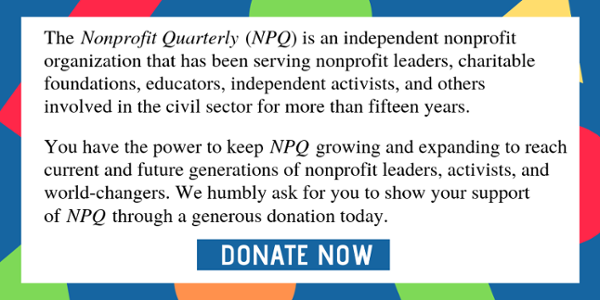
1. 2018 was the year of the “narrative.” Race was understood as playing a constant, critical, and central role in that.
At their simplest level, narratives are stories that explain the way the world works. Dominant narratives often attach to and support the intentions of current sources of power and resources. They are reiterated and reinforced in any number of ways; once embedded in public consciousness, they can be called up through the use of a single word or phrase. The power of narrative is that it often recedes into the backdrop of collective consciousness, where it lurks, directing and reinforcing actions and structures that solidify power relationships. Narrative change can occur in two ways: through challenging dominant narratives, and through developing a new, more attractive narrative to which people can and will attach.
NPQ has covered the work of narrative disruption in many ways this past year, writing about everything from the feminist fact-checking network developing across the globe to efforts to decolonize museums. In fact, that “decolonizing” story has extended far beyond museums and is a powerful notion, coming up against the trend of an ever-increasing wealth gap. In an interview leading into our recent webinar on “Remaking the Economy,” Nick Tilsen, a cofounder of Thunder Valley Community Development Corporation on Lakota land in Pine Ridge, South Dakota, and now a cofounder of a new organization called the NDN Collective, provides a rich example of what we mean when we talk about co-creating new narratives when he discusses land as something that should be stewarded more than owned.
This movement to question our own thinking, language, and assumptions in our work could not be more timely—or necessary—and it is up to us to insist that charlatans operating as consultants do not use it to establish cottage industries. This is work we have to do ourselves with one another. In a December feature titled “Signifying Blackness and the Future of Humanity,” Cyndi Suarez observes that there is plenty of such work to do in upending the assumptions that are exhibited through nonprofit communications with the public. These, she said, often reinforce the “less-than-ness” of people of color.
We fully expect this work to carry forward powerfully into coming years. Rashad Robinson of Color of Change, however, warns against the use notion of narrative as a sort of faddish fetish. He writes, “Narrative builds power for people or it is not useful at all.”

2. In the 2018 midterm elections, an unprecedented number of women of color ran for—and were elected to—a significant number of seats in the House of Representatives and to local elected offices.
Of course, this turn of events appeared to occur too often despite, rather than because of, supports from the Democratic Party structure. For example, New York City’s Alexandria Ocasio-Cortez defeated incumbent Rep. Joe Crowley despite being outspent $1.5 million to $195,000. Similarly, Ayanna Presley became Massachusetts’ first Black representative to the House despite being outspent by more than a two-to-one margin.
The 2018 elections, which had the highest turnout seen in a US midterm election since 1914, also resulted in a Congress with a record number of women—126, up from 89 in the 2016. Representation by people of color also increased, exceeding the record 106 people of color in the last Congress. Among other achievements were the election of the first two Native American women (Sharice Davids of Kansas and Deb Haaland of New Mexico) ever to serve in Congress and the nation’s first two Muslim congresswomen (Rashida Tlaib of Michigan and Ilhan Omar of Minnesota).
Even where they did not win, changes in the terms of discourse were palpable, and the idea that there was value in “looking like” and sharing the experience of an underrepresented group spread. A campaign strategist for Stacey Abrams’s campaign in Georgia noted that their approach, unlike traditional Democratic campaigns, was less about reaching the elusive middle-of-the-road voter and more “about reaching folks who do agree with us and convincing them that voting actually matters.” While Abrams did not prevail, impeded in part by voter suppression tactics, compared to the conservative politics of the state, she still outperformed most Democratic candidates for governor. Equally important, coming out of these campaigns is an infrastructure that was and is being further built to support future runs through grassroots organizing.
This constitutes an inflection point as regards to the failure of both parties to represent the interests of much of the country’s population. Gerrymandering, campaign finance manipulations and voter suppression all figure into a landscape tailor made to keep this so but our awareness of voter suppression was heightened considerably by the midterms.
The United States has always had a complicated relationship with democracy. While politicians, such as former President Bill Clinton, like to claim that the US is the “world’s oldest democracy,” the truth is more complicated. In fact, universal adult suffrage only became a reality in the US after the passage of the Voting Rights Act of 1965. Even afterward, voting rights have remained under threat. Between 1982 and 2006, the US Department of Justice and federal courts blocked over 700 changes to election laws found to be racially discriminatory. Then, in 2013, the Voting Rights Act provision that had enabled the feds to intervene those 700-plus times was invalidated by the Supreme Court in Shelby County v. Holder.
There are many subtler forms of suppressing voter turnout, like voter ID laws or gerrymandering, which doesn’t suppress votes per se, but does make people’s votes less important. Back in 2015, NPQ’s Rick Cohen noted that, “The Fifteenth Amendment to the Constitution says that no one can be denied the right to vote by virtue of their race or color, but it doesn’t stop states and local jurisdictions from employing other tactics…to make it difficult for people to exercise their franchise.”
These restrictions were hardly hidden in either 2014 or 2016—the latter an election where voter restrictions, independent of the Russians, might well have swung the presidential outcome. But it was only in 2018 when awareness of voter suppression became mainstream. The Georgia governor’s race, where Stacy Abrams officially lost by 55,000 votes in a state where as many as 340,000 voters were wrongfully pulled from the voter rolls, is the most obvious example, but not the only one. In North Dakota, the state attempted to suppress the Native American vote by requiring voters to have street addresses even if many American Indians lacked them.
The stakes are high. As Vann Newkirk details in the Atlantic, “Polling-place changes, lines, and irregularities still characterize the voting experiences of many communities of color.” Newkirk warns that, “American democracy finds itself at a crossroads, and a future where more suppression is the norm seems like a strong possibility.”
3. In 2018, the halos of philanthropy became more dislodged, and the dangers of a plutocracy supported by “charity” are not only potential or imminent, but fully present.
This year, NPQ published the first study by Dr. Patrick Rooney, which definitively confirmed that there is a trend of fewer and fewer middle- to low-income households contributing, while higher income households account for a progressively larger share of contributed dollars. This hollowing out of the middle class and an even-less-monied donor pool coupled with the wealthy donor role in politics promises nothing good for democracy or public systems like education where so many private patrons dabble in what are meant to be publicly guided endeavors. This point, which only a few of us used to make to the sound of crickets chirping, has been picked up widely in 2018 by public intellectuals, mainstream media and other elements of the philanthropic press.
This has led to a change in the way billionaire philanthropy is being discussed.
But in a move that, again, seems tailor made to worsen an existing problem, last year’s “Tax Cuts and Jobs Act” effectively ended the deduction incentive for most charitable gifts, leaving the deduction in place only for wealthier taxpayers – many of whom also make contributions to political campaigns. Thus we have charity too often working in league with other efforts to control an environment. This was addressed early in the year in a book called In Museums, Money and Politics.
Add to this the scandals involving pharmaceutical companies’ use of patient advocacy groups to “philanthropically” prop up their overpricing of drugs and the pushing of opioids, and we have what could be seen as an increasingly noxious mix.
Sign up for our free newsletters
Subscribe to NPQ's newsletters to have our top stories delivered directly to your inbox.
By signing up, you agree to our privacy policy and terms of use, and to receive messages from NPQ and our partners.
4. Economic democracy practices begin to hit the mainstream, as public subsidies of corporations become increasingly political vulnerable.
Amazon was in the news a lot in 2018. Last year, Amazon, which had frayed relations with its home city of Seattle, announced its intention to select a second headquarters city. This led to 238 proposals and wild attempts by cities—such as trying to give Amazon a 21-foot-tall cactus, which, sadly for Tucson, was not effective—to outdo each other. The scrum did secure Amazon billions in tax breaks (Bezos needed to fund his $2 billion in donation pledges somehow), but it also set off a backlash to the very idea of corporate welfare, as study after study showed that corporate tax subsidies rob money from education and are largely a waste of money. Indeed, all Google needed to do to garner positive press this month was to announce that it was adding thousands of jobs in New York City without asking for or accepting government subsidies.
A somewhat hidden part of the story was the role played by a new accounting rule, published in 2015 but not implemented until 2017, known as Government Accounting Standards Board (GASB) Statement No. 77. The rule, which was promoted for years by Good Jobs First, a small Washington DC-based nonprofit, required local and state governments—at least those interested in maintaining their credit ratings—to acknowledge publicly the costs of all the tax abatements that they provide. Sure enough, once the numbers were open to see, advocates and city council members began questioning why exactly were public monies being shunted toward corporate billionaires, a trend we can expect to continue in 2019.
This dependence upon corporations for the economic health of entire regions is being replaced with the idea that wealth should be built to be shared. Economic democracy refers to the idea that ordinary people ought to have a say over their work lives. It can take many forms—cooperatives, community land trusts, and employee stock ownership plans (ESOPs), and so on. Typically, such practices are described as economic alternatives. But in 2018, economic alternatives became significantly more mainstream.
For instance, land trusts developed in 2018 in Buffalo, Philadelphia, Reno, and Denver, among other places. Prominent efforts are also under way in Florida, in the San Francisco Bay Area, in New York City, Baltimore, and Washington, DC. And if the growth of land trusts is rapid, the growth of worker cooperatives and ESOPs is especially impressive. This culminated in the passage by Congress in August of the Main Street Employee Ownership Act, which made ESOPs and worker co-ops eligible for federally guaranteed small business loans.
5. 2018 saw the emergence of an active and sophisticated post-millennial generation.
At NPQ, we have often taken a skeptical view of the explanatory value of generations. The meaning packed into generational categories can often be highly alienating to the people so described. That said, one trend that was clear in 2018 was the social, political, and cultural emergence of young people as political actors, who, even if they don’t necessarily cohere as a “generation,” clearly are “post-millennial.” The organizing efforts of the Parkland students who “called BS” on politicians is one prominent example. But of equal if not greater importance was intense organizing in young communities of color that led to record youth turnout in November.
The rise of a new generation also shows up in ways that don’t necessarily announce themselves as such. For instance, youth leadership is highly visible in Native American organizing and in youth immigrant organizing, such as through United We Dream. In Baltimore, youth organizing after the police murder of Freddie Gray showed up in a host of new organizations like Leaders for a Beautiful Struggle, which bills itself as a “grassroots think-tank which advances the public policy interest of Black people, in Baltimore, through: youth leadership development, political advocacy, and autonomous intellectual innovation.” In Ferguson, too, after the police murder of Michael Brown, it was often teenagers who served as movement leaders; in 2018, their organizing helped topple a 28-year incumbent prosecuting attorney in countywide elections.
6. Climate change gets increasingly real.
The effects of climate change have been getting harder and harder to ignore, moving increasingly from future threat to present-day reality. For example, in October, USA Today reported that in 2018, the “Atlantic and Pacific Ocean hurricane season is [the] most powerful on record.” Meanwhile, in California, the state’s fire season was the worst on record, and British Columbia, Canada, also had its worst fire season ever.
Coupled with this were two prominent studies that documented the seriousness of the challenge. In October, the United Nation’s Intergovernmental Panel on Climate Change released a report with its sternest warning yet, predicting a “mass die-off” of the world’s coral reefs by 2040. In November, a report coauthored by 14 US federal government agencies noted that the effects of climate change were already visible, with cities like Miami, Florida and Charleston, South Carolina already experiencing a “record number of ‘nuisance flooding’ events during high tides.”
The impact of climate change, as is to be expected, has been most severe in low-income communities and communities of color, as can be most clearly seen in the continuing effects of such major 2017 hurricanes, which were still affected millions in 2018. For instance, NPQ covered a report that noted that one year after Hurricane Harvey hit Texas, “eight percent of the people impacted by the disaster have not been able to return to their homes [and] 15 percent of the hundreds of thousands of homes damaged by the storm are still unlivable.” The report also found that while two-thirds of whites said they were getting the help they needed, 60 percent of Black Texans were not. In Puerto Rico, a government-commissioned report found that an estimated 3,000 had perished due to Maria. The same report noted that mortality rates for middle class Puerto Ricans had returned to pre-storm levels within six months, but that deaths of low-income Puerto Ricans were still 50 percent higher than normal six months after the storm.
To date, policy victories to change the climate change tide have been largely conspicuous by their absence. That said, at the federal level, the Democratic takeover of the House has led to new calls for a Green New Deal and the formation of a special committee to develop an action plan that could result in a platform for 2020. Meanwhile, at the local level, some communities have taken action. Most recently, in December, the Washington, DC City Council voted unanimously to mandate that 100 percent of electricity be generated from renewable sources. As the effects of climate change become more pronounced, further policy action can be expected.
7. The nonprofit sector is increasingly called to account.
As the nonprofit sector’s leadership has taken an ever more defensive posture, resisting regulation and refusing to define itself by a consistent set of values, it has created a vacuum into which all kinds of bad practice has flowed. By refusing to more carefully hold itself to account, the sector has gradually become the refuge of all manner of schemes and that is harming the credibility of our sector. This cannot help but create a disenfranchisement of donors who don’t have the same control afforded to mega-donors as a result of their leisure time and overwhelming resources. Those donors have also been warned regularly by public officials about not falling for nonprofit charlatans. It’s a wonder anyone contributes to a nonprofit anymore, and it’s well past time to work more cooperatively with state regulators and to think less defensively about what our bottom-line value is to the world.
This year, we have seen a number of measures taken by Congress to challenge the value system of high-budget nonprofit operations. Specifically, the taxing of high-end university endowments and nonprofit salaries sends a very clear message to the sector that we can either hear…or ignore.
This year, too, was marked by a removal of rose-colored glasses and a growing recognition in the sector of a need for deeper change within every organization. “We are simply being called to live our values,” wrote Grant Oliphant, president of Heinz Endowments in NPQ earlier this year. Living our values is, of course, daunting, as Oliphant explains. For Oliphant, living our values means being willing to use our voice, get to know others, and share power.
Increasingly, nonprofits are called on to get off the sidelines and engage in critical self-reflection. This means making sure your nonprofit has procedures in place to avoid a #MeToo scandal of its own. It means challenging practices that have allowed white leadership to remain entrenched and blocked leaders of color. It means being in solidarity when needed, as in the case of Puerto Rico, still recovering from Hurricane Maria as well as colonial domination. It also means accepting the charge of building a democratic economy as part of our own. And, lastly, it means being willing to examine our sector’s practices, as in the case of donor-advised funds, and make sure frameworks are in place to prevent abuses.
We recognize our sector has a long way to go before it has actually engaged in this kind of self-reflection. But this was a year in which the contradictions were increasingly difficult to ignore, and resolving them required conscious confrontation of some of the many elephants in the room.
Correction: This article has been amended to correct the name of Rashad Robinson of Color of Change. NPQ regrets the error.












